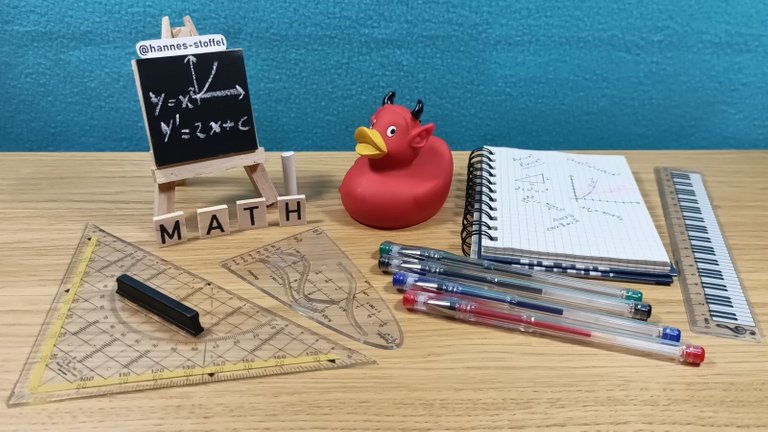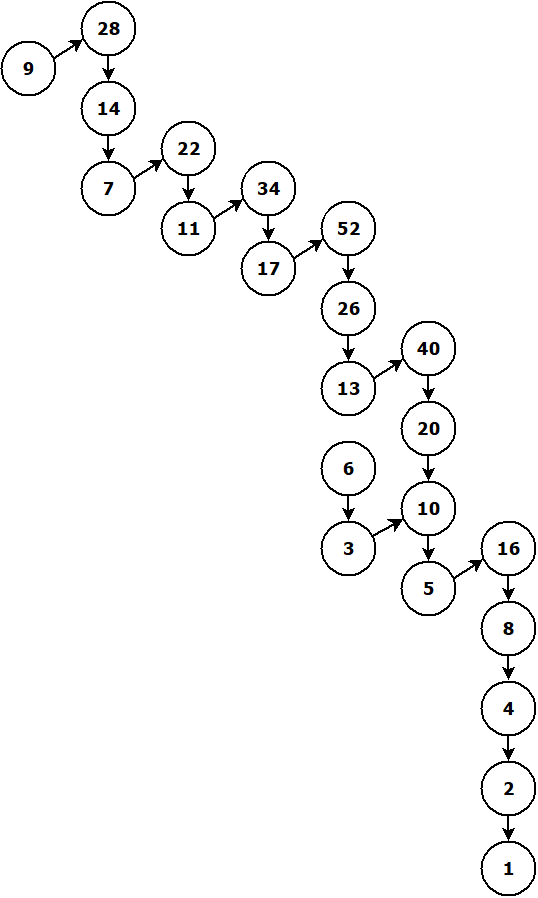Introducing The Collatz Conjecture

Introduction
Hi all. For over twenty years I have been doodling around with the Collatz conjecture. Recently I found a few of my early notes on that problem (they are spread all over the place in different boxes and folders) and I decided to make a little series of all the things I figured out so far.
Today I will just present the problem, in the following posts I will present my findings as I collected them over the years.
But be warned, even highly ranked mathematicians say this is a dangerous topic. One can quickly become obsessed with this (on first sight) simple problem and lose a lot of time to it. 😉
The Problem
The Sequence
Lothar Collatz (1910-1990), a German mathematician formulated the following sequence in 1937 as:

- Pick a positive integer (i.e. whole number bigger than 0)
- If it is even, then divide it by 2
- If it is odd, then multiply it with 3 and add 1
- Repeat step 2 or 3 with the result (depending on whether the result is odd or even)
The Example

Let us start with 5. It is odd so we multiply it with 3 and add 1:
5*3+1=16
Now 16 is even, we divide by 2 and get 8:
16/2=8
The 8 is even again, divide by 2 and we get 4, which is even again so we divide by 2 and get 2, one more time divide by 2 and we get 1.
With 1 we have an odd number so we multiply by 3 and add 1:
1*3+1=4
We know about 4, we had that just a few seconds ago. So we divide by 2 again, get 2 and divide by 2 again, we get 1 again.
We end up in a cycle 4 -> 2 -> 1 and so on.
The Conjecture
Collatz theorized that any starting number (has to be a positive integer) eventually results in the sequence 4-2-1
What is known
As you can see, the definition of the problem is very simple. Anyone can understand it and try it out. But so far no one has proven it or found any starting number that did not result in the 4-2-1 sequence.
Naturally people wrote computer programs to just brute force the problem, trying out numbers and so far no other end sequence was found. But that is no proof!
There is no real world application to this problem, it is more a tool to distract from more important math problems.
And yet its superficial simplicity attracts hobby mathematicians for many decades now. Just trying out a few numbers, looking for a pattern or the approach of a proof. Maybe even find a starting number that ends in a different sequence or better yet one that diverges into infinity?
What next
I do not have a solution or any "uh, I'm so close" article in my sleeve. But I have been doodling around with this sequence for a long time.
I know that there have been some discoveries made about a few properties of this sequence. I intentionally ignored those over the years for the pure fun of trying to figure stuff out for myself.
Since this is just a hobby of mine, the math I use is relatively simple.
Gimmick at the end
If you made it this far (in this relatively short posting) I thank you very much and leave you with some resources:
For Diagrams I use Dia
For creating math formulas as graphics I use latex.codecogs.com
The formula above was made with the following latex code:
a_1 \in \mathbb{N}_{>0} : a_{n+1}=\begin{cases}
\frac{a_n}{2} & \text{ if } 2 \mid a_n \\
3a_n+1 & \text{ if } 2 \nmid a_n
\end{cases}
Thanks for reading, enjoy your weekend, and give me some time to sort out this mess of notes 😁
In the meantime I want to make a suggestion:
When you try falling asleep, instead of counting sheep, why not try out different starting numbers in your head and see where the sequence goes? 😜
Thanks for your contribution to the STEMsocial community. Feel free to join us on discord to get to know the rest of us!
Please consider delegating to the @stemsocial account (85% of the curation rewards are returned).
You may also include @stemsocial as a beneficiary of the rewards of this post to get a stronger support.
Thank you very much. 😃
Math isn't my strong suit. :(
!PIZZA
Don't worry, for my postings it doesn't have to be. 😉
Well, in my immediate experimentation with three numbers, they certainly all resulted in the same sequence at the end. Very scientific, that.
Is math your chosen field?
!LOL
But indeed, that's how it all starts. It's not like "oh, look at this theorem, let's start writing a proof". At first it's just doodling around with it, putting in numbers and see if a pattern emerges which one day might lead to a proof or a different way to look at it.
What do you mean? We have to choose a field? No one told me. 😱 😉
I just like it as a hobby sometimes. My original field of education and vocation was computer programmer in the late 90's and early 2000's but I had to leave that field for having a burnout. But I still enjoy it from time to time as a hobby and math is a big part of it. I especially enjoy bringing math to friends of mine who think they can not do it and show them that everyone can do it.
So I finally decided to go through my old notes from back then and start writing posts about it.
lolztoken.com
A satisfactory....
Credit: reddit
@wwwiebe, I sent you an $LOLZ on behalf of @hannes-stoffel
(1/4)
Ah, that's cool! Interestingly, my education was in human communication, but then ended up in IT, which I am also looking to get out of. I remember damn near failing math in college!
Thank you.
Strange how life turns things around every now and then :-) My education is in IT and now I'm in logistics (in a store).
Yes, math at college can be harsh. Glad you were only near to failing and pulled through :-)